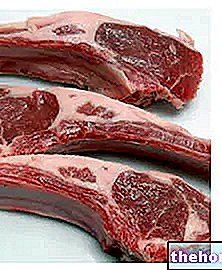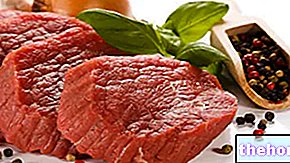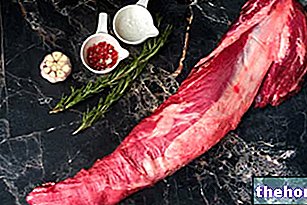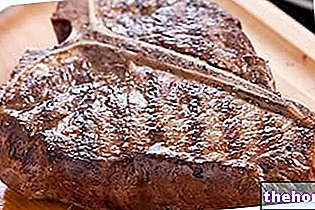Generality
Though Kebab is a Turkish term *, in common language it is used to indicate a "wide range of meat foods - packaged in the form of a skewer, then skewered and grilled - originating in the Middle East and then widespread throughout the Balkan area, in the Caucasus , in Europe, Central and South Asia etc.

Due to the considerable heterogeneity of the kebabs offered in the various areas of Italy and the rest of the world, it is very difficult to express a "single nutritional evaluation of the food"; however, by estimating the caloric intake of the different types of raw material used and considering the method cooking, it is possible to say that kebab, similar to our "grilled meat", is a highly energetic dish, rich in proteins, saturated fats and cholesterol, characterized by the presence of toxic molecules (polycyclic aromatic hydrocarbons).
* The term "kebab" is subject to various interpretations and linguistic distortions. While in the East the word kebab indicates all types of meat cooked on the fire, in English for kebab we mean only the shish kebab (turkish skewer); in many areas of Italy, on the other hand, when ordering a kebab, a pita or Arabic type sandwich will be served, filled with grilled meat (called Doner kebab or Shawarma or Gyro); this preparation is called dürüm kebab, from the name of the typical Turkish bread (dürüm) similar to Italian piadina and Mexican tortilla.
Beyond the various territorial interpretations, the "real" kebab is a dish consisting of skewers cooked on the grill, composed of various pieces of meat and coming from very different animals (but always in compliance with specific Middle Eastern religious prohibitions). The beast traditionally most used in the formulation of the kebab is the sheep, in particular the lamb or the mutton; there is no shortage of goat, beef, chicken, pork and fish kebabs.
Currently, for most Western cultures, kebab is considered an ethnic dish that is perfectly integrated into the local culture. The word kebab most likely derives from the terms "kabab - kababu - kbaba" which, in Arabic - Akkadian - Syriac, mean "to fry or burn". It seems that kebab has very ancient roots (more than western fast-food restaurants); it is hypothesized that the first forms of kebab appeared between Greece and the Middle East several centuries before the birth of Christ. Some findings indicate that, in medieval times, this cooking method was a fundamental survival expedient for Persian soldiers who stabbed food directly on their sword, cooked them on fires and consumed them directly on the battlefield.
The popular kebab in Italy - Doner kebab, Shawarma or Gyro?
The food typically distributed in Italy under the name of kebab is none other than the dürüm-kebab, that is a sandwich of Turkish bread (dürüm), Arabic (pita) or Armenian (lavash) stuffed with Doner kebab (Turkish version); the same name is also improperly used for very similar meat preparations but of different origin, such as Shawarma (Arabic version) and the Gyro (Greek version). The misunderstanding probably arises from the fact that all three use the same cooking method; these "kebabs", in fact, use a vertical grill (usually electric) as a heat source near which, by means of a motorized tool, the huge spit of meat turns on itself, cooking evenly on the outside. The cooked kebab is then thinly sliced and possibly kept warm in the metal plate located at the base of the instrument (or in a food warmer), before being served as a dish or for the filling of the famous sandwich. Doner kebab and its variants can also be used as a filling ingredient for pizza.
Many will wonder why the "kebabbaro" continues to slice the meat even when he has no orders in sight; actually the answer is very simple. This cooking method is as banal as it is delicate; letting the kebab continue to cook indefinitely would cause two problems: 1. The drying of the external meat; 2. Failure to cook the internal one. This means that, once the surface layer is cooked, either the process is interrupted or the process continues to cook after having sliced the outermost kebab. There is also a further problem of a methodological type; cooked and sliced meat, if not promptly served, tends to become excessively dehydrated, losing its organoleptic and taste characteristics. For this reason, at the base or next to the kebab, there is always a large metal plate (or alternatively a food warmer) filled with vegetable oil in which to drown the slices of meat until the moment of serving. This is the fundamental reason why kebabs also fall into the category of high-calorie fast food.
Hygienic aspects
Referring to Doner kebab, Shawarma and Gyro, it is essential to make some observations of hygienic and nutritional interest. Without mentioning any brand name, many kebabs have undergone (and still are) subjected to various qualitative and compositional checks. The results are rather worrying as there are continually episodes of food fraud and micro-biological contamination.
It seems that the compositional analysis of these enormous kebabs reveals certain "more or less meat" ingredients that are not present on the specific food label. In the best case scenario, the foreign element is made up of other types of meat (often various kinds of offal emerge) , but there are reports for the presence of: cartilage, bones, teeth and eyes.
We also remember that Doner kebabs are made up of pieces of raw meat stacked on top of each other and then frozen; this feature requires a certain care in maintaining the cold chain since, unlike any WHOLE block of meat, the kebab makes use of a greater surface area useful for bacterial proliferation. This means that a "possible interruption of the cold chain or unsuitable storage of meat (due to the negligence of merchants and couriers) could easily create a" suitable environment for bacterial growth (especially staphylococcus and coliforms) as a potential cause of toxic infections. even serious food.
Furthermore, although large kebabs are placed on the rotisserie still frozen (which does not facilitate cooking but greatly shortens consumption times), it is essential to remember that to consume a kebab of considerable size, sometimes, it takes several days. In my opinion, this is a rather risky practice.
Last but not least, the hygiene level guaranteed by the operator; in addition to kebabs in any form of fast-food (especially street food), it is always essential to evaluate the cleanliness of the worktops, cooking surfaces and, why not, also refrigerators (peeking when opening and closing). Citing kebabs, I invite all readers to evaluate (first of all) the degree of cleanliness of the dish located at the base of the large skewer (where the meat is collected) and, of course, of the cutting boards as well as the tools (knives, pliers , razors, etc.). In the event that a certain hygienic "carelessness" is evident, I strongly suggest giving up the coveted meal without delay.
Nutritional characteristics
As anticipated, it is not easy to make a nutritional assessment of such heterogeneous preparations as kebabs; taking as reference the durum kebab (sandwich), it is possible to say that it is a high-calorie food and very rich in fats (saturated in the meat and, at best, unsaturated in the oil with which it is kept tender after cutting). cholesterol while the fibers are more or less deficient depending on the addition or not of raw and cooked vegetables in the filling. Furthermore, although pita or Arabian bread is NOT a particularly elaborate or lipid-rich derivative of cereals, it still contains high percentages of complex carbohydrates, which contribute to further increasing the energy density of the kebab. The proteins are of high biological value but, as well as the vitamin and salt content, do not justify the frequent consumption of the product.
The kebab is therefore a food not suitable for the diet against overweight and that for hypercholesterolemia. The relative recommended average portion does not exist, since the kebab does not have a "unique shape and the" padding varies according to the "hand" of the operator. . A sporadic and unsystematic consumption is recommended.
Other Foods - Amatriciana Meat Lamb - Lamb Meat Duck - Duck Meat Pork Chop Florentine Steak Boiled Broth Raw Meat Red Meat White Meat Beef Horse Meat Rabbit Meat Pork Meat Vegetable Meat Lean Meat Sheep and Goat Meat Carpaccio Ribs Cotechino Cutlet Snails or land snails Pheasant and Pheasant meat Guinea fowl - Guinea fowl meat Pork fillet Chicken Hamburger Hot Dog Kebab Patè Chicken breast Turkey breast Chicken - Chicken meat Meatballs Porchetta Quail - Quail meat Ragù Sausage Game Zampone OTHER ARTICLES MEAT Categories Food Alcoholic Meat Cereals and derivatives Sweeteners Sweets Offal Fruit Dried fruit Milk and derivatives Legumes Oils and fats Fish and fishery products Salami Spices Vegetables Health recipes Appetizers Bread, Pizza and Brioche First courses Second courses Vegetables and Salads Sweets and Desserts Ice creams and sorbets Syrups, liqueurs and grappas Preparations of Basic ---- In the Kitchen with Leftovers Carnival Recipes Christmas Recipes Diet Recipes Light Recipes Women's Day, Mom, Dad Functional Recipes International Recipes Easter Recipes Recipes for Celiacs Recipes for Diabetics Recipes for Holidays Recipes for Valentine's Day Recipes for Vegetarians Recipes Protein Regional Recipes Vegan Recipes
















.jpg)











